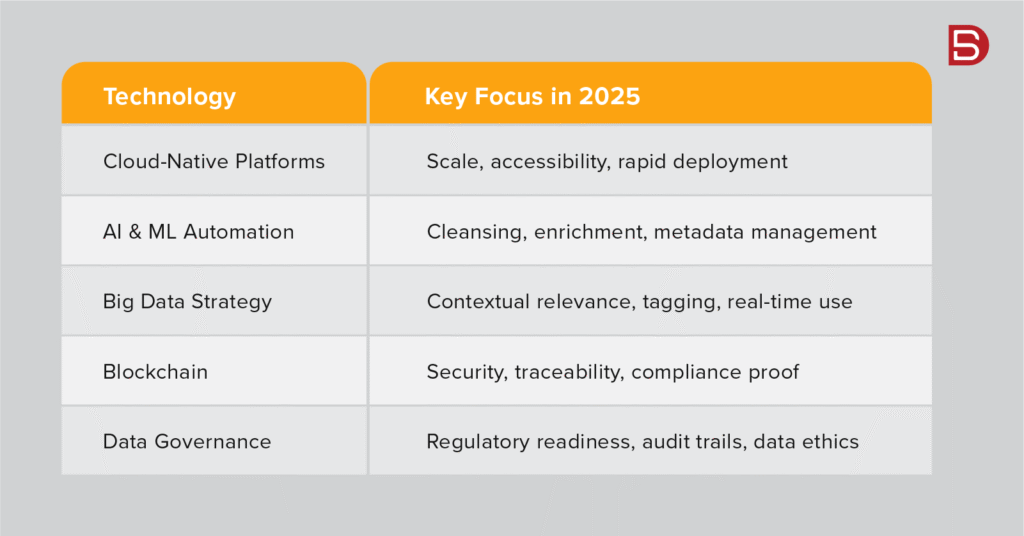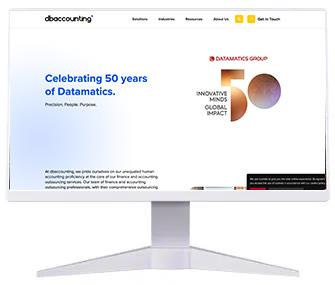Accurate data is no longer a luxury. It is a requirement for B2B companies looking to compete in the digital-first world. In fact, according to a study by Experian, more than 95% of businesses claim that data is essential to their success, but nearly one in three suspects that poor data quality is hindering their performance.
And they’re not wrong. From mismatched customer profiles to unreliable lead scores, messy data can quietly erode marketing ROI, sales velocity, and informed decision-making.
That’s where data management solutions come in. These platforms help companies move beyond scattered spreadsheets and legacy systems. It provides them with the tools to sort, verify, and effectively utilize their data in ways that drive results.
Whether it’s keeping your records clean, surfacing new insights, or making sure sales and marketing teams are looking at the same customer story—these systems are becoming the backbone of modern B2B growth.
In this blog, we’ll unpack what makes data management solutions so valuable right now. We will also explore the latest technologies reshaping this space in 2025 and beyond.
Spoiler: It’s not just about having more data, it’s about knowing what to do with it.
What are the Real Benefits of Data Management Solutions?
In today’s B2B landscape, having large amounts of data isn’t an advantage. It’s knowing what to do with it that counts. Yet most companies are still struggling to make that data usable.
According to Gartner, poor data quality costs organizations an average of $12.9 million per year in lost productivity, missed opportunities, and compliance issues.
That’s why more companies are turning to data management solutions. These tools help them organize and maintain data.
Here’s how these solutions can move the needle.
1. Smoother Daily Operations
Manual workarounds eat up time. AI-powered data management platforms take on heavy lifting. This includes pulling data from different systems, cleaning it, and making it usable. This frees teams to focus on insights and execution rather than fixing CSV files.
Did you know? Nearly 60% of employee time goes trying to locate or validate information.
2. Reliable, Decision-Ready Data
Data is only helpful when it’s accurate. Most AI-powered data management solutions help identify duplicates, correct gaps, and standardize formats. This makes it easier to trust the numbers you see. And that trust matters when you’re making decisions that impact revenue.
According to Experian, 91% of companies believe insufficient data is undermining their business performance.
3. Everyone Works from the Same Page
Having one central place where data lives reduce confusion. Whether you’re in sales, marketing, or finance, you’re looking at the same updated customer or performance information. So, no more wondering which spreadsheet is the “latest.”
4. Instant Access to What Matters
With real-time dashboards and alerts, decision-makers don’t have to wait for end-of-week reports. Whether it is tracking revenue, customer behavior, or product issues, they can see what’s happening now, and act while it still matters.
5. Better Team Collaboration
When data lives in silos, it gets lost or duplicated. Centralizing data makes it easier for teams to share their knowledge, ask more informed questions, and work toward the same goals. This is particularly important for companies with distributed workforces (for example, those based in Europe but hiring in New York through a tool like Remote) as it minimizes the challenges posed by cultural barriers and time zone differences. It’s not about software. It is about visibility.
6. Fewer Costly Mistakes
When you don’t have to second-guess your numbers, you avoid spending time (and budget) fixing preventable errors. Centralizing and cleaning your data also reduces risk of non-compliance, especially in regulated industries.
IBM estimates the global cost of poor data quality is $3.1 trillion annually.
Managing data on a scale doesn’t need to be an in-house burden. That’s why many companies choose to partner with data quality service providers. This allows them to help structure, audit, and maintain data health, while focusing on growth
Emerging Technologies Shaping B2B Data Management in 2025

B2B Data management isn’t what it used to be. In 2025, it’s no longer just about storing information. The trends are leading towards making that information usable, secure, and ready to support real-time decision-making.
The technologies driving this change are evolving fast, with organizations rethinking how they manage, move, and monitor data.
Here are the five key tech trends shaping B2B data management this year.
1. Cloud-Native Data Platforms Are Becoming the Norm
Cloud-based data management is no longer the future; it is the present. THEY ARE DEFAULT. A 2025 IDC report predicts that over 80% of enterprise data workloads will be processed in the cloud. Companies are transitioning away from legacy systems in favor of platforms that provide global accessibility, reduced infrastructure overhead, and improved scalability.
Cloud-native data tools enable faster access, continuous updates, and seamless integration with other cloud services. In a landscape where downtime and lag cost money, being cloud-ready is no longer optional.
2. AI Is Taking Over Core Data Tasks
Artificial Intelligence (AI) and Machine Learning (ML) are now central to how companies handle data. These technologies automatically identify duplicate records, enrich missing fields, detect anomalies, and even classify unstructured data. Gartner notes that by the end of 2025, most of us will use AI to do 60% of data management tasks. This shift is helping teams focus less on data hygiene and more on using data to support strategy, personalization, and forecasting.
3. Big Data Is Driving Better Context, Not Just More Volume
By the end of 2025, the average enterprise is expected to manage over 10 petabytes of data. This figure is doubling every two years. But volume alone isn’t the challenge; it is making that data contextually relevant.
Today’s advanced data quality management solutions use AI to tag, structure, and contextualize data in ways that make it useful across teams. Be it marketing, product, or compliance. The focus has shifted from “how much” to “how meaningful.”
4. Blockchain for Data Integrity and Proof
Blockchain is emerging as a real option for managing sensitive or high-value data. Its tamper-proof structure makes it attractive to sectors like finance, healthcare, and defense.
In 2025, companies are starting to test blockchain technology to verify data provenance, ensure audit trails, and mitigate manipulation risks. While it’s still early for mass adoption, the momentum is growing.
5. Data Governance Is Front and Center
Blockchain is emerging as a real option for managing sensitive or high-value data. Its tamper-proof structure makes it attractive to sectors like finance, healthcare, and defense.
In 2025, companies are starting to test blockchain technology to verify data provenance, ensure audit trails, and mitigate manipulation risks. While it’s still early for mass adoption, the momentum is growing.
Must-Have Features in Data Management Solutions for 2025
Data isn’t slowing down. In 2025, businesses are navigating more complex data, more regulations, and more sources of information than ever before.
According to IDC, global data creation is expected to reach 175 zettabytes by the end of 2025. The challenge isn’t just handling that volume. It is using it in ways that actually serve business goals.
Here’s what top-performing data management solutions will deliver in 2025.
1. Built for Scale—Without the Growing Pains
As companies collect data from more channels—such as IoT, apps, CRM, customer support, and third-party APIs—the ability to scale storage and processing power is critical. Platforms need to support real-time growth, not just long-term storage.
Note: Enterprises managing petabyte-scale data grew by 41% in the past year, and that trend continues.
2. Centralized Command Over Chaos
Data still lives in silos for many businesses. Today’s solutions must integrate data from across various systems. This includes cloud apps, on-premises tools, and partner feeds, making them searchable, usable, and current.
Whether you are working with a customer record or product SKU, having it centralized makes all the difference in day-to-day decisions.
3. Quality Isn't a Bonus—It's Non-Negotiable
A clean dataset means fewer errors and more informed decisions. Modern data quality management capabilities must offer built-in tools for de-duplication, normalization, and cross-platform validation. These aren’t “nice-to-haves”. They’re critical.
Survey: 91% of IT leaders cite data accuracy as the #1 factor impacting operational effectiveness.
4. Stronger Security, Smarter Access
Security expectations are rising. With threats evolving and compliance laws tightening (CPRA, GDPR, India’s Digital Personal Data Protection Act), platforms must support field-level permissions, audit trails, encryption, and real-time monitoring.
Fact: The average cost of a data breach in 2024 reached $4.45 million, up 15% over three years.
5. Governance Without Friction
Organizations now need to prove not just how they store data, but also how they use it. Today’s solutions should support rule-based workflows, consent tracking, lineage visualization, and policy enforcement that are built into the platform.
Governance is no longer the compliance team’s job—it’s part of the data stack.
6. Real-Time Feedback, Not After-the-Fact Reports
Modern data management tools are increasingly expected to surface trends, exceptions, or anomalies as they happen. Dashboards should refresh instantly, with alerts that flag critical issues before they snowball.
Trend: Real-time analytics adoption has grown 35% year-over-year, especially in customer-facing industries like retail and telecom.
7. Smarter Spending, Not Just Cost Cutting
Today’s cloud-native platforms offer flexible pricing—pay for what you store, use, or analyze. More importantly, they help businesses identify data waste, underused assets, and unnecessary duplication that silently drains budgets.
8. Visuals That Make Data Clear
It’s not enough to have data—you need to see it. Today’s users want dashboards that are interactive, intuitive, and insightful. Visual cues help teams across departments understand what the data is telling them, without needing to be analysts.
To Note: Teams using data visualization tools make decisions 5x faster than those relying on raw reports.
Why Now Is the Time to Rethink Your Data Strategy?
As we move deeper into a data-first economy, the stakes have changed. It’s no longer about collecting more data. It’s about trusting what you have, using it in real-time, and ensuring it’s secure, accurate, and aligned with your goals.
In 2025, businesses are navigating unprecedented volumes of information, growing regulatory pressure, and rising expectations for speed and precision.
A modern data management solution isn’t just a backend utility. It is a growth enabler. From smarter decision-making and cross-team alignment to reduced risk and better customer understanding, the value is both strategic and measurable.
Whether you’re an early-stage company building your data foundation or an established enterprise untangling legacy complexity, now is the right time to invest in tools that help you clean, control, and capitalize on your data—before your competitors do.
If you’re ready to take the next step, Datamatics can help you turn scattered data into a strategic advantage. Get in touch with our experts and see how data empowers your business like never before.
Subscribe to our blogs and stay on top of the latest data trends.

James Libera


